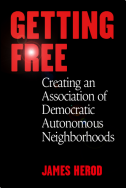Decision-Making in Dyads,
Or Two-Person Splits
James Herod
February 1974
The most obviously unique thing about decision-making between two people is the impossibility of majority rule. Majority rule does not necessarily provide a way of resolving differences in triads, quadriads, or larger groups since, even given a prior commitment to go along with the majority decision, majority rule breaks down at the point where the majority decides to execute the dissident member. Here the operative principle becomes not majority rule but sheer power. Nevertheless, majority rule does seem to provide a way for voluntary organizations to function democratically since no one is forced to be a member and can resign or withdraw from the organization if differences with majority policy become too great. Or, in the case where there is a significant block of dissidents united around a common view, they can leave en masse or else try to take over the organization, i.e., they can split. In the case of society at large however majority rule could provide, if flowing out of a `network of workers councils united on the basis of direct democracy,' a democratic and socialist way for policy to be formulated. The fact that the majority decision is imposed by force, if necessary, on the minority recognizes the social nature of society and avoids the trap of individualism, while the fact that it is the majority's will which is imposed, not a minority's (i.e., some elite's), recognizes the dialectical nature of human consciousness and the fact that there is no such thing as true or false but only agreement and disagreement.
Decision-making in the dyad is a different problem altogether, or at least it seems to be. Whether or not it actually is may become clear further along in the analysis.
I thought I had clarified the whole mess about domination/passivity, tolerance/intolerance in my essay on four-way criticism, but recent continuing reflections on `tolerance' have confused the whole picture again. How can a marriage last, since total agreement is an impossibility, unless one partner or both tolerates opinions they disagree with? Since decision-making is a constant necessity when two people do things together, some way has to be established for this to take place. But what way? I do not think that I have ever seen a relationship or experienced one where this was not accomplished through the bourgeois duality. Either the woman makes all (or most) of the decisions, perhaps going along on occasion with the man, or else the man does. This is almost always a permanent dynamic of the relationship.
The dynamic can usually be deciphered by watching even a mundane decision being made (or experience it being made as a participant). Do we walk down that block or this block, turn this way or that, and so forth? Does the woman follow the man's lead or the man the woman's as they are walking down the street? We have to catch the underlying dynamic though and not be mislead by outward form. For example, a common physical stance is for the woman to hook her hand and wrist through the man's slightly crooked arm. Most of the time the man is leading. But in many couples the same physical form in maintained but the woman is clearly leading, indicating when to stop, when to start across the street, which way to turn, when to window shop, how fast to walk, and so forth.
Perhaps there are rare couples which are not lopsided and where they go his way about as much as they go her way. Usually these are not peaceful matches but fighting matches. We have all seen couples that fight constantly about everything and seem always on the verge of splitting up. A closer look might reveal that these are the best matches. Each partner is active and guards his or her turf, always ready to defend it and ward off any impositions. Peaceful matches are probably based on the passivity of one of the members. Whether or not there are peaceful relationships between two active and evenly matched (equally strong) partners is hard to say. It is surely an exceedingly rare case, if it even exists at all under current conditions.
One traditional device to avoid having to battle and negotiate on each and every mundane decision is the division of labor. This is usually a traditional division, not a conscious one, but it could just as well be a consciously chosen practice, agreed upon by both partners. One partner would make the decisions in some areas and the other partner would make the decisions in other areas, and each would go along with the decisions of the other.
A second device that is usually present to some degree in all but the most lopsided matches is rotation. One partner decides this time and the other next time. (Obviously, the division of labor device could be combined with the rotation device.) Rotation is rarely used explicitly however. It is often present, but only informally, not as a conscious decision-making strategy for arriving at policy....(Unfinished)

